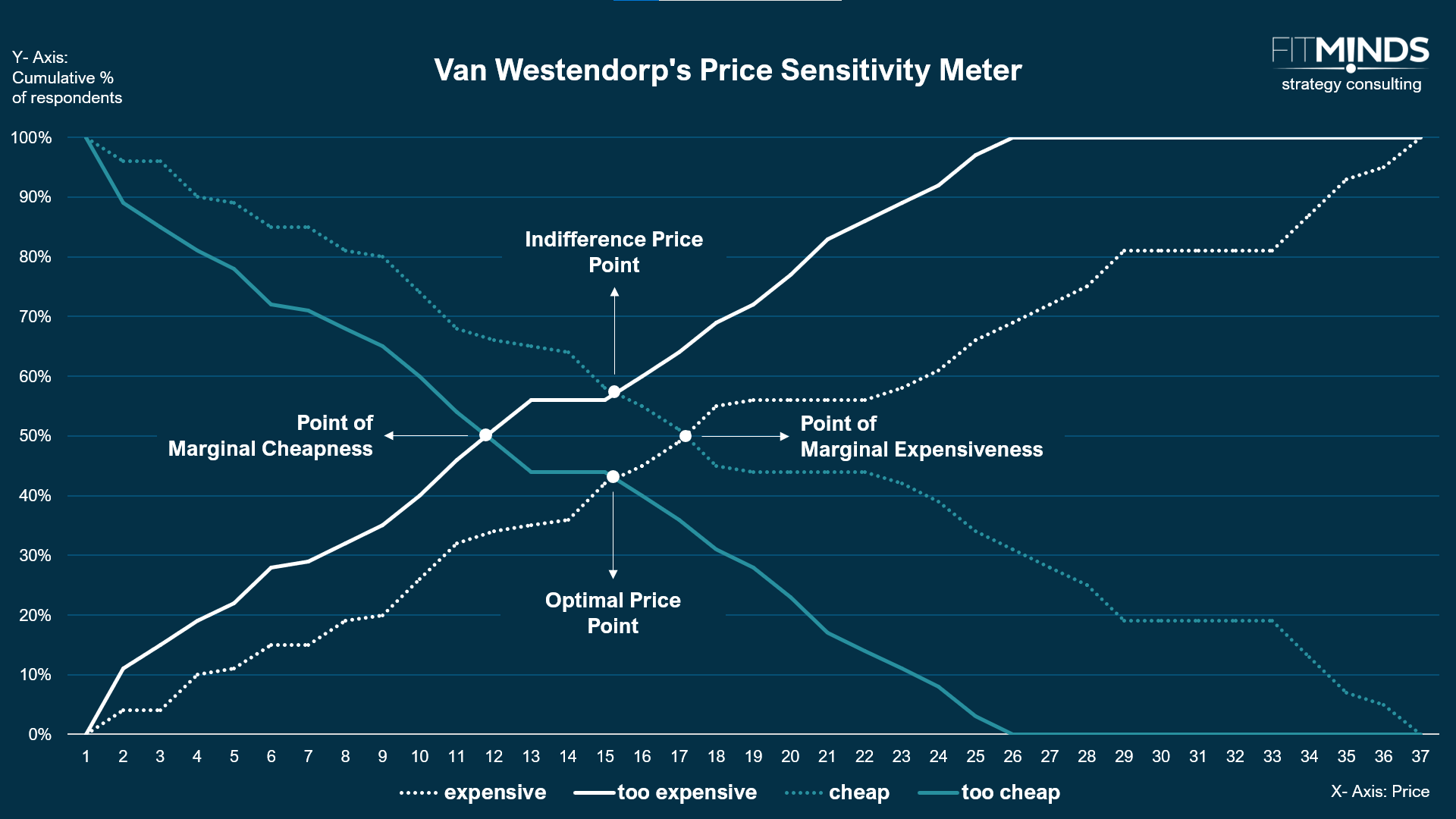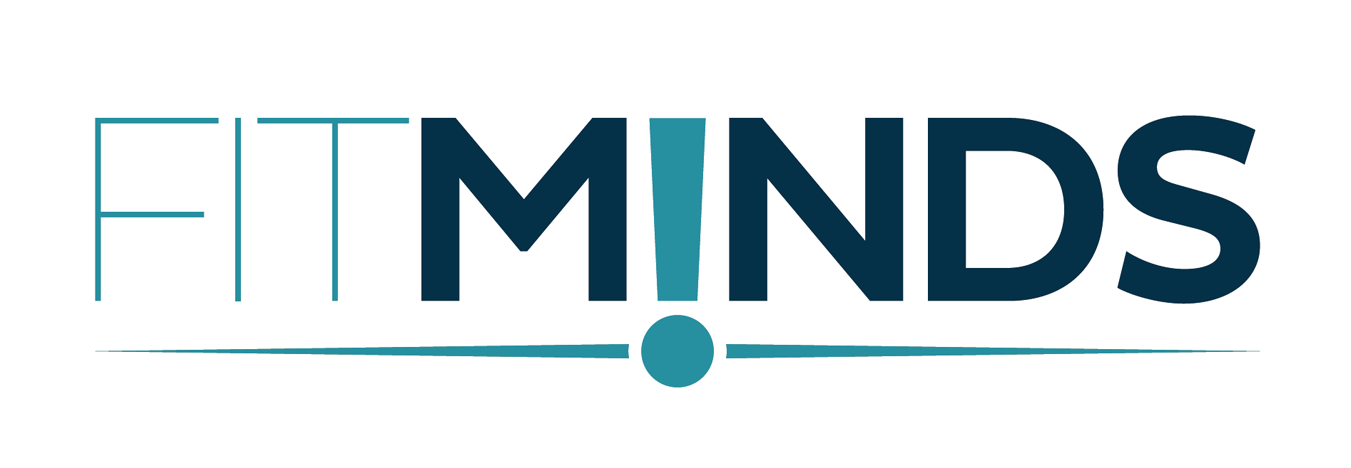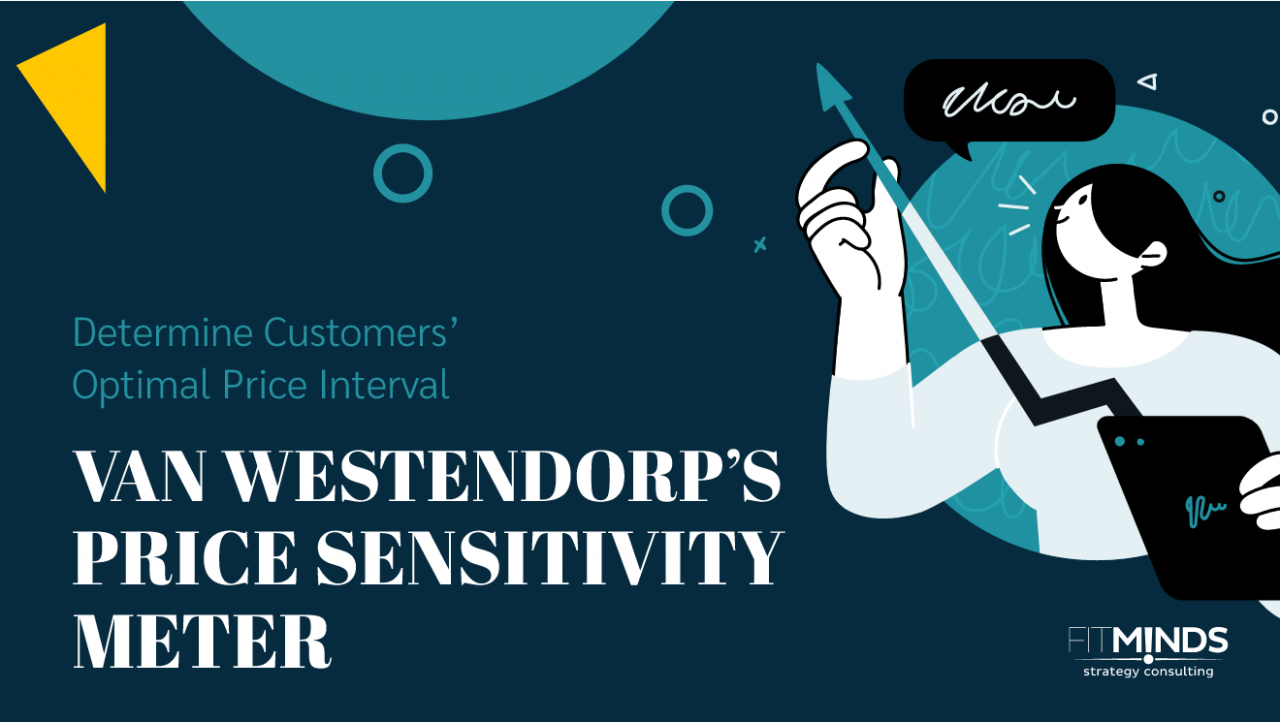Van Westendorp’s Price Sensitivity Meter, was developed by Peter Van Westendorp to identify optimal price corridor through 4 questions to be asked customers.
Main Benefits of Van Westendorp’s Price Sensitivity Meter:
Van Westendorp’s Price Sensitivity Meter helps you:
- define optimal price interval for your product,
- understand potential impacts of price change,
- determine pricing strategy.
Explanation of Van Westendorp’s Price Sensitivity Meter:
Van Westendorp’s Price Sensitivity Meter ask potential customers 4 questions and identifies 4 alternative price sensitivy lines:
- too expensive to buy,
- expensive yet acceptable,
- cheap but will be trusted,
- too cheap to be trusted.
Intersections of these four lines are critical price points that can be taken into account to define optimal price interval.

Point of marginal cheapness: The intersection of the “too cheap” and “expensive” lines is the point of marginal cheapness. At his point, the number of participants who view the product as “too cheap to be trusted” is equal to the number of participants who view the product as “expensive yet acceptable”. If the price is set below this point, more customers will say that the product is too cheap to be trusted. Therefore, this point acts as a lower bound of acceptable prices.
Point of marginal expensiveness: The intersection of the “cheap” and “too expensive” lines is the point of marginal expensiveness. At this point, the number of participants who view the product as “cheap but will be trusted” is equal to the number of participants who view the product as “too expensive to buy”. If the price set above this point, more customers will say that the product is too expensive to buy. Therefore, this point acts as a upper bound of acceptable prices.
Optimal price point: The intersection of “too cheap” and “too expensive” lines is the optimal price point. At his point, the number of participants who view the product as “too cheap to be trusted” is equal to the number of participants who view the product as “too expensive to buy”. Here, the number of customers who would possibly consider purchasing the product is at maximum.
Indifference price point: The intersection of “cheap” and “expensive” lines is the indifference price point. At his point, the number of participants who view the product as “cheap but will be trusted” is equal to the number of participants who view the product as “expensive yet acceptable”.
Therefore, according to the Van Westendorp’s Price Sensitivity Meter, optimal price is some point between the point of marginal cheapness and the point of marginal expensiveness. Optimal price point and indifference price point are two alternatives.
How to Apply Van Westendorp’s Price Sensitivity Meter:
- Share necessary information about your new product with the participants
- Ask participant below 4 questions:
- At what price would you consider this product to represent a good value? (cheap)
- At what price would you say this product is getting expensive but you would still consider it? (expensive)
- At what price would you say this item is so expensive that you would no longer consider it? (too expensive)
- At what price would you say this items is so inexpensive that you would begin to question its quality? (too cheap)
- Prepare a graph with four line charts:
- X-axis: price of the product in increasing order
- Y-axis: cumulative percentage of participants
- Identify intersections
Additional Tips and Readings:
Pricing is one of the most tricky part of the marketing. Although Van Westendorp Price Sensitivty Meter offers a simple analytical tool that can be applied in many situations, customers may react irrationally to prices. There are cases in which increasing price resulted in increased demand. Therefore, we encourage you to conduct small experimentations before applying the outcomes of this model.
Also, we listed some of our articles that may inspire you while determining your pricing strategy:
- You can read USP to think about possible ways to increase your customer willingness to buy.
- To assess financial implications of alternative prices, you can apply Break-Even Analysis.
- Perceptual Mapping may help you figure out your price level compared to that of your competitors.
- Building Personaswill help you picture your participants while applying Van Westendorp Price Sensitivty Meter.
Contact us to determine a well-thought-out pricing strategy.



13 comments
Pingback: purchase androxal without prescriptions uk
Pingback: Us enclomiphene without a perscription
Pingback: price of rifaximin 100 mg number 30
Pingback: buy cheap xifaxan purchase from uk
Pingback: buy staxyn online canada
Pingback: avodart pills from canada
Pingback: online order dutasteride purchase prescription
Pingback: how to buy flexeril cyclobenzaprine buy singapore
Pingback: canadian pharmacy gabapentin pills 100 mg
Pingback: kamagra dodání ve stejný den
Pingback: kamagra aucun médecin ne consulte
Pingback: how to buy fildena generic europe
Pingback: discount itraconazole without recipe
Comments are closed.